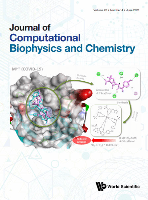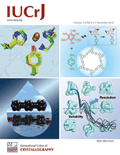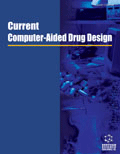
Journal of Computational Biophysics and Chemistry
Scope & Guideline
Pioneering Discoveries at the Intersection of Chemistry and Computation
Introduction
Aims and Scopes
- Computational Drug Design:
The journal frequently publishes research related to the computational design, molecular docking, and dynamics simulations of potential therapeutic agents, targeting various diseases including cancer, viral infections, and bacterial infections. - Molecular Modeling and Simulations:
A significant focus is on molecular modeling techniques, including molecular dynamics simulations, quantum mechanical calculations, and docking studies, which are employed to explore molecular interactions and predict biological activity. - Bioinformatics and Systems Biology:
Research in bioinformatics, including gene expression analysis, protein-protein interaction networks, and systems biology approaches, is crucial for understanding complex biological systems and disease mechanisms. - Machine Learning and AI in Chemistry:
The journal highlights the application of machine learning and artificial intelligence in drug discovery, molecular modeling, and data analysis, aiming to enhance predictive accuracy and efficiency in computational studies. - Natural Products and Phytochemistry:
There is a notable interest in the computational exploration of natural products derived from plants and their potential therapeutic effects, emphasizing the integration of traditional knowledge with modern computational techniques.
Trending and Emerging
- Artificial Intelligence and Machine Learning Applications:
There is an increasing trend in the application of AI and machine learning techniques in drug discovery, molecular modeling, and predictive analytics, showcasing the potential for these technologies to revolutionize computational studies. - COVID-19 Related Research:
The journal has published a significant number of papers focusing on SARS-CoV-2, exploring potential inhibitors, vaccine candidates, and therapeutic strategies, highlighting the urgent need for research in response to the pandemic. - Integrative Approaches Combining In Silico and In Vitro Studies:
There is a growing emphasis on studies that integrate computational methods with experimental validation, reflecting a trend towards more comprehensive research methodologies that bridge computational predictions with laboratory results. - Natural Product Drug Discovery:
Research exploring the therapeutic potential of natural products, particularly in the context of drug discovery against contemporary health challenges, is increasingly prominent, indicating a revival of interest in traditional medicine combined with modern techniques.
Declining or Waning
- Classical Molecular Dynamics without Advanced Techniques:
There has been a noticeable reduction in studies employing classical molecular dynamics simulations without the integration of more sophisticated techniques such as enhanced sampling or hybrid quantum mechanics/molecular mechanics methods. - Basic Theoretical Studies in Chemistry:
Research centered solely on fundamental theoretical chemistry concepts, without application to specific biological or medicinal contexts, appears to be less prevalent, as the journal shifts towards more application-driven studies. - Traditional QSAR Models:
The use of traditional quantitative structure-activity relationship (QSAR) models without the incorporation of machine learning or advanced computational techniques has decreased, indicating a shift towards more innovative methodologies.
Similar Journals

Doklady Biochemistry and Biophysics
Transforming Research into Understanding in Biochemistry and BiophysicsDoklady Biochemistry and Biophysics is a vital resource for the advancement of knowledge in the fields of biochemistry and biophysics, published by MAIK NAUKA/INTERPERIODICA/SPRINGER. Featuring an ISSN of 1607-6729 and an E-ISSN of 1608-3091, this journal plays a critical role in disseminating research findings and fostering scholarly discourse. Despite its recent ranking in the Q4 quartile for biochemistry and biophysics in 2023, it serves as an essential platform for researchers exploring these intertwined disciplines. The journal’s scope encompasses a wide variety of topics, enhancing the understanding of biochemical processes and physical principles in biological systems. With converged years of publication from 2001 to 2024, it stands as a continual source of knowledge for its readers, who include researchers, professionals, and students alike. While the journal currently does not offer open access options, its contributions remain significant within the scholarly community, illustrated by its competitive Scopus rankings across related fields.

CELL BIOCHEMISTRY AND BIOPHYSICS
Connecting Biochemistry, Biophysics, and Cell BiologyCELL BIOCHEMISTRY AND BIOPHYSICS is a distinguished journal published by HUMANA PRESS INC, focusing on critical advancements in the fields of biochemistry, biophysics, and cell biology. Since its establishment, the journal has provided a robust platform for the dissemination of cutting-edge research, covering diverse aspects of cellular biochemistry and the physical principles that underlie biological systems. With an emphasis on interdisciplinary studies, the journal aims to facilitate knowledge exchange among researchers, professionals, and students from various scientific backgrounds. As reflected in its 2023 category rankings, it holds a respectable position in Q3 for Biochemistry and Cell Biology, and Q2 for both Biophysics and Medicine (miscellaneous), indicating its significant contribution to these fields. Although it operates under a subscription model, the journal's commitment to maintaining high publication standards ensures that only impactful studies are shared with its audience. With a range of articles spanning theoretical insights to practical applications, CELL BIOCHEMISTRY AND BIOPHYSICS is an essential resource for those aiming to stay at the forefront of biochemical and biophysical research.

Chemical Biology & Drug Design
Innovating at the crossroads of science and therapeutic applications.Chemical Biology & Drug Design, an esteemed publication by WILEY, serves as a vital platform for the dissemination of pioneering research in the interdisciplinary fields of biochemistry, drug discovery, molecular medicine, organic chemistry, and pharmacology. With a dedicated commitment to advancing the understanding of chemical interactions and drug development, this journal not only fosters innovation but also bridges the gap between theoretical research and practical applications. It boasts an impressive impact factor and is recognized in the 2023 category quartiles as Q3 in Biochemistry and Molecular Medicine, and Q2 in Drug Discovery, Organic Chemistry, and Pharmacology, indicating its relevance and influence in these crucial areas. The journal’s rankings across various Scopus categories further solidify its position as a reputable resource for researchers, professionals, and students striving to stay at the forefront of medicinal chemistry and drug design. While primarily traditional access-based, the journal's evolving scope from 2006 to 2024 ensures an ongoing contribution to essential scientific dialogue, making it an indispensable read for those committed to advancing health sciences.

IUCrJ
Unlocking the Secrets of Matter and LifeIUCrJ, published by the International Union of Crystallography, is a leading open-access journal dedicated to advancing knowledge in the fields of Biochemistry, Chemistry, Condensed Matter Physics, and Materials Science. Since its inception in 2014, IUCrJ has quickly established itself as a prestigious platform for high-quality research, achieving a remarkable record as a Q1 journal across its categories in 2023. With an increasing impact in the scientific community, evidenced by impressive Scopus rankings, IUCrJ offers unparalleled access to groundbreaking discoveries and methodologies that contribute to the understanding and application of crystallography in various disciplines. The journal’s commitment to open access ensures that research is readily available to a global audience, fostering collaboration and innovation in the scientific community. IUCrJ is an essential resource for researchers, professionals, and students aiming to stay at the forefront of crystallographic research and its interdisciplinary applications.

RUSSIAN JOURNAL OF BIOORGANIC CHEMISTRY
Pioneering Discoveries in Biochemistry and Organic ChemistryRussian Journal of Bioorganic Chemistry (ISSN: 1068-1620, E-ISSN: 1608-330X), published by MAIK Nauka/Interperiodica/Springer, serves as a vital resource for researchers and professionals in the fields of bioorganic chemistry, biochemistry, and organic chemistry. With a focus on the integration of organic chemistry principles with biological processes, this journal aims to disseminate significant findings and advancements from both theoretical and practical perspectives. Although currently not open access, the journal retains a dedication to high-quality, peer-reviewed content, contributing to its reputation within the academic community. The 2023 Scopus rankings position it within the Q4 category for both biochemistry and organic chemistry, indicating its critical niche within these disciplines amid a competitive landscape. Since its inception in 1996, the journal has continued to evolve, providing enriching insights and fostering collaborations among scholars and practitioners alike, with publication converging up to the year 2024. By exploring complex biomolecular interactions and the synthesis of biologically relevant compounds, the Russian Journal of Bioorganic Chemistry remains a significant platform for advancing knowledge and innovation in the life sciences.

MOLECULAR DIVERSITY
Exploring the Frontiers of Molecular ScienceMOLECULAR DIVERSITY, published by Springer, stands as a pivotal platform within the fields of chemistry, biology, and pharmacology since its inception in 1995. This esteemed journal aims to foster interdisciplinary research and innovation, particularly in areas such as catalysis, drug discovery, inorganic and organic chemistry, and molecular biology. With a diverse scope that reflects contemporary scientific challenges, it has been recognized for its significant contributions, boasting commendable Scopus rankings and an impact factor that underscores its relevance in critical fields. Although not an open access journal, MOLECULAR DIVERSITY continues to influence and engage researchers, professionals, and students alike by providing a forum for high-quality peer-reviewed articles and cutting-edge research findings. As it converges years of scientific dynamism from 1995 to 2024, this journal remains vital for those advancing the frontiers of molecular science and engineering.

Journal of Cheminformatics
Connecting chemistry and computing for a brighter future.Journal of Cheminformatics, published by BMC, is a premier open-access journal that has been a cornerstone of cheminformatics research since its inception in 2009. With an ISSN of 1758-2946, this journal operates from the heart of the United Kingdom, providing a dynamic platform for disseminating high-quality, peer-reviewed articles that explore the integration of computer science with chemistry. The journal proudly stands in the prestigious Q1 category across multiple disciplines, including Computer Graphics, Computer-Aided Design, and Library and Information Sciences, showcasing its exceptional impact in the fields of cheminformatics and computational chemistry. Additionally, it ranks impressively in various Scopus categories, with notable placements such as #7 in Library and Information Sciences and #15 in Physical and Theoretical Chemistry, demonstrating its significance to the academic community. As a leader in open-access publishing, the Journal of Cheminformatics ensures that cutting-edge research and innovations are freely accessible to researchers, professionals, and students alike, fostering collaboration and advancement in this rapidly evolving field.

INDIAN JOURNAL OF BIOCHEMISTRY & BIOPHYSICS
Elevating knowledge in biochemistry and biophysics.INDIAN JOURNAL OF BIOCHEMISTRY & BIOPHYSICS is a well-regarded academic journal that serves as a vital platform for researchers in the fields of biochemistry and biophysics. Published by the NATL INST SCIENCE COMMUNICATION-NISCAIR since its inception in 1972, this Open Access journal has committed itself to disseminating high-quality research and advancements in these dynamic fields, allowing readers worldwide to access vital findings since 2009. The journal maintains a robust presence in the academic landscape, achieving noteworthy rankings in 2023, placing it in the Q4 category for Biochemistry and Q3 for both Biophysics and miscellaneous Medicine, alongside its respectable Scopus rankings. With an emphasis on original research articles, reviews, and educational contributions, the INDIAN JOURNAL OF BIOCHEMISTRY & BIOPHYSICS plays an essential role in fostering scientific dialogue and collaboration among professionals and students alike. For scholars seeking to stay at the forefront of biochemistry and biophysics research, this journal is an indispensable resource that fosters knowledge exchange and elevates the field on both a national and international scale.

Biophysical Reviews
Shaping the Future of Biophysical Research TogetherBiophysical Reviews, published by SpringerNature, is a leading international journal focused on the interdisciplinary areas of biophysics, structural biology, and molecular biology. With an impressive 2023 impact factor, the journal ranks in the Q1 category for biophysics and is also highly regarded in structural and molecular biology, reflecting its commitment to advancing understanding in these critical fields. Operating since 2009 and converging toward its goal of comprehensive coverage by 2024, Biophysical Reviews provides a platform for researchers to share innovative insights and critical reviews that shape the future of biophysical sciences. Its rigorous peer-review process ensures high-quality publications that are closely monitored within the academic community, making it an essential resource for researchers, professionals, and students aiming to stay at the forefront of biophysical research. Access options are available for enhancing the dissemination of knowledge, supporting a broad audience dedicated to scientific excellence.

Current Computer-Aided Drug Design
Advancing Drug Discovery Through Computational InnovationCurrent Computer-Aided Drug Design, published by BENTHAM SCIENCE PUBL LTD, is a pivotal journal dedicated to the integration of computer-aided methodologies within the drug design process. With its ISSN 1573-4099 and E-ISSN 1875-6697, this journal serves as a vital resource for researchers, professionals, and students interested in advancing the fields of pharmacology and molecular medicine. Operating under a framework that spans from 2006 to 2024, it aims to foster innovative approaches and discussions surrounding drug design strategies, computational techniques, and the therapeutic potential of novel compounds. Although it currently holds a Q4 rating in Drug Discovery and Molecular Medicine as well as a Q3 in Medicine (miscellaneous) within the 2023 category quartiles, the journal continues to enhance its visibility and relevance in the academic community. Its Scopus rankings reflect its commitment to quality research, positioning it in the context of drug discovery and molecular studies. As the field of drug design evolves, Current Computer-Aided Drug Design remains an essential platform for disseminating cutting-edge findings and facilitating collaboration among specialists aiming for significant advancements in drug development.